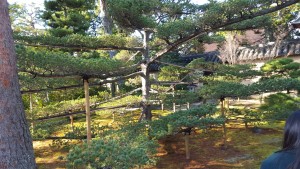Today we visited Daitoku-ji, a temple compound dating back to the 1300s. As we entered, I was impressed by the extreme attention to detail in the gardens. Though I did expect them to be well-maintained, actually seeing people picking up individual pine needles was a bit hard to believe. This micro-scale focus in fact extends to larger compositions. One of my favorite examples was a tree in front of Daisen-in:
Looking carefully you can see that every branch is supported by bamboo scaffolding. In front of this tree Professor Ludvik said that monks would often tell her things like, “This tree will be perfect in 70 years”. Evidently many of these gardens are being maintained with even the far future in mind. This planning is obvious in the case of trees but it made me wonder how the rock gardens might attempt to respond to the passage of time. Do the patterns in the rocks change every so often or are they static? Because many that we saw featured large rocks, I get the impression that they must be relatively unchanging.
One practice that rose to the forefront of my experience was taking off our shoes at every temple. It mainly came to my attention because we visited a number of sub-temples and I was wearing boots that were rather difficult to remove and put back on. I couldn’t help but chuckle a bit when we talked about the seamless integration of indoor and outdoor spaces; there was definitely a seam: my boots. This, along with the obsessive manicuring of nature in the gardens left me wondering if imposing such an unyielding set of rules was really the best way to commune with nature.
This remote feeling of dissonance continued as we discussed the terribly strict routine of the monks, whose daily existence is a choreographed exercise in self-denial and frugality. Is there not lushness and chaos in nature? Are we not already subject to the same laws as the “natural”? If not, why should we be? One aspect of the artifice that I can appreciate is that it sets the chaos of nature in high relief. In other words, a single cherry blossom falling into a completely clean pond seems to have more impact than one falling into a pond already littered with them. All of the routine and rules are “cleaning the pond”, allowing even trivial disturbances to be seen. Regardless, I wonder if there isn’t something lost in trying to keep such a clean slate. If you brush away every snowflake as it falls you can keep the area around you perfectly clean. But by the end of the storm you’ll find that the only pockmark in the landscape is the spot that you’ve so diligently maintained.
